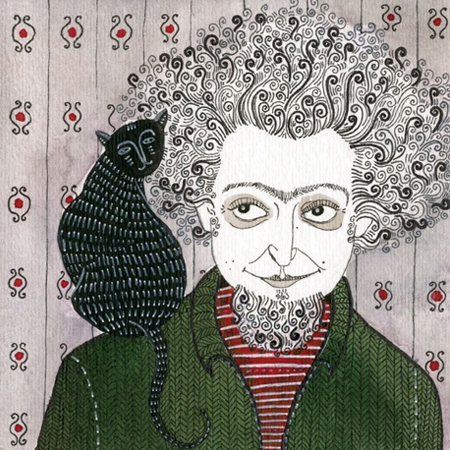
Warning! What follows isn’t a paragraph as arrogant or an example of vanity run amok as it might seem; and I’ll try to justify its aspiration and ambition in my conclusion.
Oh, how about a holiday column about yours truly? Jim Yood’s art criticism may just possibly put him among that small group of major critics and pundits who today occupy a solid position of distinction within our art community. Month by month, column by column, artist by artist, Yood’s writing displays brilliant and succinct command in its analysis of stylistic and visual aspirations from a surprisingly broad group of artists, with a profound and thoughtful grasp of art history and a rich and rhythmic vocabulary that carry him toward conclusions and insights that just sound right, skillfully uniting form and function in his writing. Though VAS is lucky in all of its columnists — all truly thoughtful wordsmiths of skill and wisdom — Yood has a kind of gift for writing about his actual local physical turf, Chicago and Illinois particularly, but also art doings from Wisconsin, Indiana, Michigan, Missouri, Iowa, Kansas, Ohio, Arkansas (Canada too, strong on Toronto, Ottawa and Calgary) and platforms of art such as painting, drawing, printmaking, glass and photography. His thinking about Pop, Minimalism, Cubism, Dada, Land Art, Chicago Imagism, and, too, his ongoing Jungian psychoanalytical study on various cultural positions of artists such as Andy Warhol, Pablo Picasso, Donald Judd, Sandro Chia, Titian, Wassily Kandinsky, Frida Kahlo, Ivan Albright, Sarah Lucas, John Currin, Grant Wood, Oskar Kokoschka, Jim Nutt, Van Gogh, Salvador Dali, Jackson Pollock, Gladys Nilsson and Paul Gauguin has had broad scholarly impact on both psychiatry and art history. Yood’s forthcoming book, “In Poussin’s Shadow: Musings on Rococo Painting by Fragonard, Chardin, and Oudry” will go to print this coming July.
Now, some of you have undoubtedly figured out that this previous paragraph is an example of a lipogram, which is defined as a constrained writing or word game often pursued by writers. The paragraph (and the lead above it) is comprised of exactly 299 words in which I told remarkably little truth, and did not in a single instance use the letter “e,” the letter most often employed in the English language. Lipograms in all their variety are good writers' games, as they force one to be a walking thesaurus, as well as to be clever enough to come up with alternatives that will still at least somewhat work. If you want to use the word “conceptual” as in the e-challenged exercise above, well, you can’t. So your mind starts reeling around ways you can parallel the forbidden e-laden word (you know, “On Kawara sought an art from his brain, not from his wrist, placing his thinking far in front of his doing or making.”).
It might not be the absolute best or most precise way to think about writing, but it does make you attentive to options, it makes word choice about parsing things very carefully, weighing each decision. I’ve long had the secret wish to submit an entire exhibition review for publication without using an “e”, you know, “Nancy Holt’s post-minimalism isk cold and aloof, and, as shown at Gagosian this month, it can also still hint at making a maximum out of a minimum of visual stuff.” (By the way, if I wrote and submitted such a review without my editor’s permission and it somehow snuck into publication, I might very well be dismissed if my little game were subsequently discovered; writers are not generally allowed to toy about in such a manner.)
For a while I thought I had invented a word game from those that involve typing. At odd moments — for instance, on long airplane flights — I've tried to think of 8-letter words that you would type, following standard keyboard formats, using each digit exactly once (excluding thumbs of course, in standard usage thumbs don’t type letters). A word such as ‘captions’ does it, as does ‘pleasing’ and ‘pralines’ (seems you’re stuck with a ‘p’ every time), but I came up with about a dozen words that fulfilled it, and it’s hard, off-hand, for me to remember a greater moment of personal joy than when I got ‘pralines’ on a redeye flight from San Diego to Chicago. Then I googled this exercise and eventually found that others had tried it as well, and indeed had come up with more than I had. There are many such exercises, more than I had ever imagined.
The brain is a restless organ, and letters and words are the ultimate tools of a writer’s craft. Sometimes, I think, even more so than ideas, which often change (did you ever hear the writer’s creed? “Give me this day my daily idea, and forgive me for the idea I had yesterday.”).
One last e-challenged note — Happy Thanksgiving to all of you from all of us at VAS, and hoping you and your family can wait a fortnight until VAS picks up its torch again!
